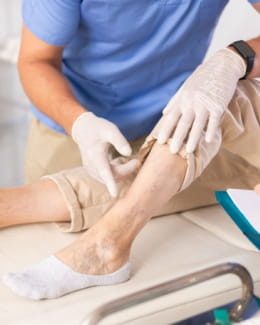About Varicose Veins
Varicose veins are bulging, enlarged veins. Any vein close to the skin's surface, called superficial, can become varicosed. Varicose veins most occur in the veins in the legs. That's because standing and walking increase the pressure in the veins of the lower body.
For some people, varicose veins are simply a cosmetic concern. Spider veins are also a common, mild form of varicose veins. But, varicose veins can cause aching pain and discomfort. Sometimes they lead to more serious health problems.
Varicose veins might not cause pain. Symptoms of varicose veins include:
- Veins that are dark purple, blue or the same color as the skin. Depending on skin color, these changes may be harder or easier to see.
- Veins that look twisted and bulging. They often look like cords on the legs.
When there are painful symptoms of varicose veins, they might include:
- An achy or heavy feeling in the legs.
- Burning, throbbing, muscle cramping, and swelling in the lower legs.
- Worse pain after sitting or standing for a long time.
- Itching around one or more of the veins.
- Changes in skin color around a varicose vein.
Spider veins are like varicose veins, but they're smaller. Spider veins are found closer to the skin's surface and might look like a spider's web. Spider veins occur on the legs but also can be found on the face.
Causes and Risk Factors
Veins work with other blood vessels to provide proper blood flow throughout the body and return blood back to the heart. In the legs, veins have one-way valves that prevent blood from flowing backwards. One-way valves and muscle contractions work together to move blood upward toward the heart, counteracting gravity.
As a result of factors such as age, gender, genetics, and other health conditions, the walls of these veins can weaken, and the valves may fail to close properly. This leads to blood pooling, which causes the veins to bulge and twist. These changes can result in pain, leg fatigue, and a feeling of heaviness.
The pooling of blood can also lead to swollen feet and ankles, itching, skin changes, and increased bleeding from minor cuts. If not addressed, varicose veins can progress to more serious conditions, such as ulcerations.
-
A physical exam
-
Duplex Ultrasound
-
Venogram
-
Sclerotherapy
-
Endovenous Laser Therapy (EVLT)
-
Radiofrequency Ablation (RFA)
-
Vein Stripping and Ligation
-
Ambulatory Phlebectomy
-
VenaSeal Closure System
Here are some practical tips for managing varicose veins:
- Move your legs often to support blood circulation and talk with your doctor about what exercise options are best for you
- Avoid tight clothing on your legs, waist, groin or pelvis area as it can restrict blood flow and worsen symptoms
- Monitor your symptoms and call your primary care doctor or vascular specialist if you experience any increased pain, skin discoloration, swelling or develop any wounds on your skin around your varicose veins
- For women, be aware of hormonal changes such as pregnancy, menopause, and talk with your primary care doctor or vascular specialist about the use of birth control medications and how those may affect varicose veins
-
Can varicose veins be prevented?While it’s not always possible to prevent varicose veins entirely, there are steps you can take to reduce the risk of developing them such as exercising regularly like walking, swimming, or cycling, which helps improve circulation and strengthens vein walls. Maintaining a healthy weight reduces pressure on the veins. If possible, avoid standing or sitting for long periods, or change positions often and elevate your legs whenever possible. Eating a balanced diet high in fiber and low in salt can help reduce pressure on the veins.
-
If I have one varicose vein, does that mean I will get more?While having one varicose vein does increase the likelihood of developing more over time, it doesn't guarantee you’ll develop more. Getting varicose veins is influenced by several factors, and if you already have one, there may be underlying issues with the vein function in your legs like weakened valves or poor circulation that could make you more prone to developing others in the future.
-
Do compression socks really help varicose veins?Compression socks or stockings help by applying gentle pressure to your legs to improve blood flow and reduce swelling. While they don’t treat the veins, they may help with symptoms. They come in different levels and your vascular specialist can help determine which level of support you may need.
Find a Vascular Surgeon
Think you have or may need further treatment for varicose veins? Let us help you find the right doctor. A primary care doctor such as an internal medicine or family practitioner can often start the diagnostic journey for varicose veins. If you’ve already been diagnosed and want to discuss additional treatment options, a vascular surgeon usually performs treatments for varicose veins. Use our referral form or call (855) 233-0888 and we’ll help you find a doctor that meets your needs.



